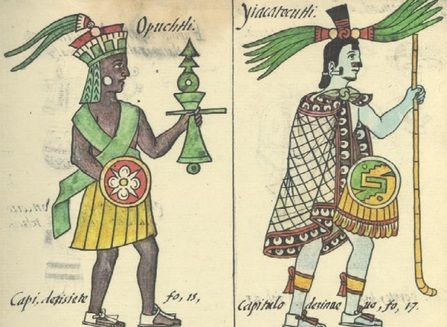Florentine Codex, grand intellectual enterprise of the 16th century
Elaborated under the orders of Fray Bernardino de Sahagún, the Florentine Codex was made by a group of 20 tlacuilos or painters and four indigenous masters.

Elaborated under the orders of Fray Bernardino de Sahagún, the Florentine Codex represents the great intellectual enterprise of the 16th century and one of the greatest works of expression in the 'America of the Renaissance', having been made from a group of 20 tlacuilos or painters and four indigenous masters.
In 1576, an epidemic was depleting the population of the capital of New Spain while, at the Colegio de la Santa Cruz de Tlatelolco, Fray Bernardino de Sahagún and a score of tlacuilos were working on the work known today as the Florentine Codex. In an unusual act, those Nahua painters decided to stay in the city and finish the text, even at the risk of contracting the infection and perishing.
Also called Historia general de las cosas de Nueva España, it is the first great mestizo work elaborated in what is now Mexico, whose information can be read in Nahuatl, in the paraphrase of some of its contents, in Spanish, and the third one of visual character.
The compendium is divided into 12 books: I on the gods; II on ceremonies and festivals; III on the origin of the gods; IV on the divinatory calendar; V on omens; VI on rhetoric; VII on the moon and stars; VIII on kings and lords; IX on merchants; X on vices and virtues; XI on nature and the elaboration of colors and the codices themselves; and a book XII that narrates the Conquest and the fall of the ancient city of Mexico-Tenochtitlan.
The Florentine Codex, like many other indigenous documents of the 16th century, has an equal testimonial rank with the chronicles of the conquistadors or the letters of Hernán Cortés himself, in which he spoke of the empire he discovered and ended up dominating. The wisdom of the ancient Mexica, embodied in the aforementioned document, is evident in the episode of Book XII, which narrates how Moctezuma's emissaries visited Cortes' ships and gave him a series of the attire of deities such as Quetzalcoatl and Tezcatlipoca.
More than a simple present, as it is often said, these emissaries and Moctezuma himself intended to know the intentions and character of Cortés according to the attire he chose, since, in his cosmovision, by selecting a garment, the conqueror would become an ixiptla, that is, a representation or a bearer of the attributes of the numen.
Another example of how the 20 artists and four master painters -who to this day have been recognized in the manuscript- captured the presence of their ancient customs and beliefs, is in folio 228 of Book VII, which illustrates the mythical passage of the rabbit that the gods placed on the moon to dull the brightness of the sun.
Bilingual and bicultural, this ancient encyclopedic work was written in two columns, one in Nahuatl and the other in Spanish as a summary, it consists of four thousand pages in two thousand folios, handwritten in perfect columns, and two thousand 686 images also handmade and colored; each book is accompanied by a prologue by Sahagún that places the work in dimension and in the context of its time.
The Florentine Codex is a faithful testimony of the role played by indigenous intellectuals in the cultural process of the 16th century, because these grammarians, who spoke three languages: Nahuatl, Latin, and Spanish, could write and read all the texts of European tradition, while incorporating their three thousand years of writing and manufacturing and conception of colors, to make a bicultural work, where I, the indigenous, explain to you, the westerner.
How the tlacuilos experimented with new pictorial techniques
Notwithstanding this experimentation, the indigenous intellectuals insisted on expressing their knowledge, traditions, and myths through the use of external techniques. This could be determined from the study of the treatises on color and pigment reproduction from the contents of Book 11 of the codex.
The paintings that integrate the Florentine Codex are not only representations, they are an epic of creation, that is to say, the tlacuilos repaint the indigenous world that had ended with the Conquest, but now in the context of New Spain, because they had no precedents for tomorrow, that is why it was necessary to say it again, and in that lies the importance of the document.
The work is composed in three volumes, like the European encyclopedias, with a total of 12 books, and as in the medieval editions, it divides the knowledge in the world of divinities, men, nature, and animals.
The Florentine Codex more than revolutionizing the culture of its time is a revolutionary act in itself since it is an illuminated bilingual encyclopedia, where the pictography uses all the tradition of the colors of the Mesoamerican world and expands to paint in the manner of the Renaissance; the painters are seen as great artists interested in adapting their technique and their knowledge to this new expansion of the image.
The magnitude of this intellectual enterprise of the 16th century occurred in the context of the plague that wiped out 80 percent of the indigenous population at the time; that is why this ancient document is an example of the commitment of 20 Nahua authors who decide to finish the work even though their teachers, friends, and relatives are surely dying or have died.
Thus, a group of tlacuilos and grammarians locked themselves in the Imperial College of the Holy Cross of Santiago Tlatelolco to finish the work although they are surrounded by death. This attitude gives more value to this writing, through which Sahagún recovers the indigenous knowledge knowing that it was in the process of dying out due to all the circumstances that characterized the Colony.
Source: INAH




